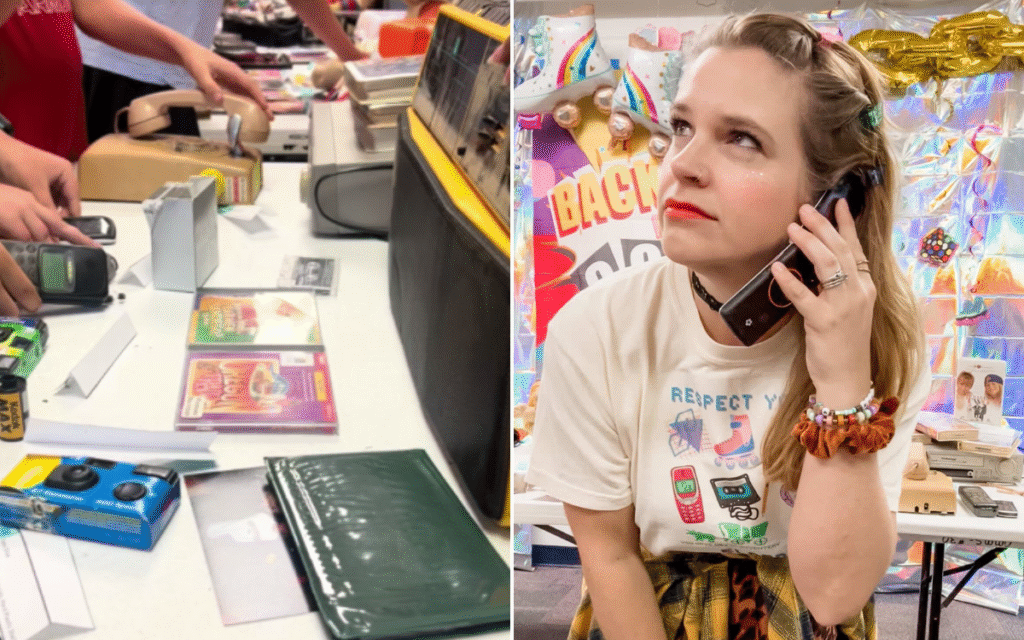A history teacher in Alabama left her sixth-grade class astounded with a showcase of “artifacts” from her childhood.
Malinda Nichols has taught history for 10 years and always strives to bring creative flair to the classroom, whether it’s crafting parachutes like the ones the “Candy Bomber” used to deliver treats during the Berlin Airlift or tracing the journey to the 1969 Woodstock Festival.
“My students don’t just memorize ‘dates and dead people,'” Nichols told Newsweek. “They step into the shoes of the people who lived and created history through hands-on simulations, civil discourse, examining multiple perspectives, asking hard questions, creative writing, and primary source analysis.”
Nichols is right to take this focus. A survey of just over 1,800 people by the American Historical Association found a little over three out of every four high school students polled felt history focused on memorizing names, dates and facts.
Her aim is to make it “active, relevant and deeply human.” That aim was what informed her creation of the “Museum of the Millennial” for a recent sixth grade social studies class.
It was an idea that first sparked to life last summer, during a family vacation in Colmar, France. “We visited a toy museum with a perfectly preserved 1980s childhood bedroom on display,” said Nichols.
By creating an exhibit that revisited the technology and pop culture of her youth, Nichols saw an opportunity to get her students thinking about history and how “their parents live it and even they are stewards of their own historical legacy.”
As a teacher of modern U.S. history, she often found herself during lessons on topics like the Cold War and fall of the Berlin Wall telling classes “your parents lived through this, talk to them about it.”
The Museum of the Millennial felt like a natural extension of this but, in order to be effective, it would require the ideal primary sources; the parents. She emailed moms and dads pitching an idea for a “reverse show and tell” where they would come in and surprise the class by presenting on the personal cultural touchstones that shaped their young lives.
“The response was incredible,” Nichols said. “Parents supplied every artifact you see except the orange New Kids on the Block lunchbox, that one is mine.”
On the day of the museum’s opening, Nichols had parents hide in the hallway, while she “dialed into” AOL Instant Messenger before opening the door to reveal her guest historians: the assembled crew of parents, many of whom dressed up in clothes of the era.
Everything was done with a focus on helping students understand the major cultural and technological shifts that shaped their parents’ generation. “We raised Tamagotchi pets and felt the thrill of seeing Home Alone in a packed theater. We watched the twin towers fall in real time. We saw the rise of Blockbuster, the birth of YouTube, and the shift from landlines to cellphones. We were the ones who said goodbye to analog and hello to the digital age,” Nichols said. “That’s pretty historic.”
The response among students was a mix of excitement and shock. “I passed out questions for them to ask that aligned with my state’s history standards like, ‘How did you find your way before GPS’ and ‘Would you consider yourself a latchkey kid?,” Nichols said. “They couldn’t fathom how long it took for us to do things they take for granted.”
Parents explained how to get Nintendo cartridges to work, the best method for rewinding a cassette tape, the lengths they had to go to find out how much a baseball card was worth and what texting on a PalmPilot was like. “I even did a small group instruction on how to play POGS!” Nichols said
The next day kids were allowed to pick one item from the previous lesson to research further. “The most popular were Beanie Babies, Tamagotchis, and the Furby,” she said.
A regular presence on TikTok and Instagram with posts shared under the handle @hipsterhistorywithmrsn, Nichols’ Museum of the Millennial ended up going viral on TikTok, with a video showcasing the day’s activities racking up almost 800,000 views.
While the extra attention is undoubtedly motivated in part by nostalgia, Nichols hopes her efforts show the possibilities when subjects like history are taught “with purpose, creativity, and emphasizes the connection of our shared humanity.”
The Museum of the Millennial gave students a chance to compare and contrast the world of yesterday with life as we know it now. It gave Nichols the chance to do the same.
“The best part was growing up without hyper-connectivity and constant access to everything. Ask any teacher, and they’ll tell you that the skills built through productive struggle have left the building. Why take the time to understand an issue when an influencer, AI, or Google can just tell you?,” she said.
“However, growing up as a millennial also meant pioneering the internet with no parental safety controls. AOL chat rooms were our Wild West.” There have been improvements though. “The internet and social media have also created space for more voices in much-needed conversations that were often dismissed when millennials were growing up,” she said.
Right now Nichols is the one comparing then with now, but one day, those sixth graders will be the ones fielding questions from kids asking about what 2025 was like. They will have quite a story to tell.
Read the full article here


